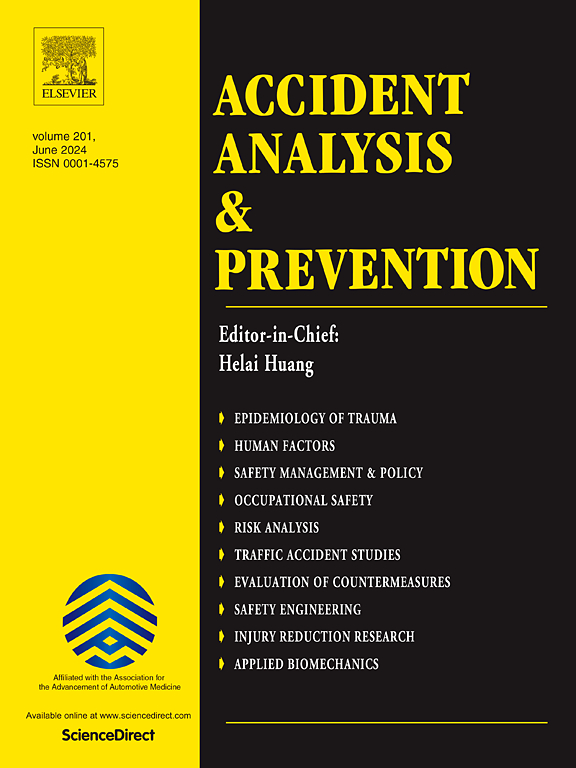IF 5.7
1区 工程技术
Q1 ERGONOMICS
引用次数: 0
摘要
在不受控制的交叉路口,由于没有交通信号灯或明确的路权指引,来自不同方向的驾驶员要根据自己的感知和实时判断来做出何时以及如何通过或让行的战略决策。这种决策的不确定性如果被误判,可能会导致车辆碰撞。在本研究中,我们开发了一个网络化双车驾驶模拟平台,进行了模拟直行车辆(SG)和左转车辆(LT)在无控制交叉路口相互作用的实验,并重点探讨了可能影响驾驶员过街决策的因素。通过分析车辆加速度随冲突距离(DTC)变化而变化的序列,我们首先确定了标志着从稳定决策到动态决策转变的关键过渡状态,有助于确定驾驶员做出交叉口或让行决策的时刻。然后,通过研究临界过渡状态下的车辆运行指标并结合人为因素,建立了一个相关随机参数随机遗憾最小化二元对数模型,以研究影响 SG 和 LT 驾驶员做出交叉路口决策的诱因。结果表明,单个速度和 DTC 对 SG 或 LT 驾驶员的过街决策均无显著影响,但两车之间的速度差和 DTC 差等变量却有显著影响,这凸显了进行双车模拟以捕捉交互变量的重要性。此外,在人为因素方面,处罚记录对 SG 和 LT 驾驶员的交叉路口决策都有显著影响。收入水平对 SG 司机的交叉路口决策有重要影响,而性别则是影响 LT 司机交叉路口决策的重要因素。此外,本研究还发现,对于 SG 车辆,速度差与 DTC 差之间的权衡值主要集中在 5 至 6 之间,即每 1 米/秒的速度差对应于 5 至 6 米的 DTC 差对过街决策的影响。对于轻型车辆,权衡值主要在 3 至 5 之间。这些发现对于开发联网车辆信息系统和支持降低碰撞风险的政策制定工作非常有价值。本文章由计算机程序翻译,如有差异,请以英文原文为准。
Strategic crossing decisions in vehicle interactions at uncontrolled intersections: A networked driving simulator study
At uncontrolled intersections, without traffic signals or explicit right-of-way guidance, drivers interacting from different directions depend on their perception and real-time judgment to make strategic decisions about when and how to cross or yield. This uncertainty in decision-making, if misjudged, may result in vehicle collisions. In this study, we developed a networked two-vehicle driving simulator platform, conducted experiments to simulate the interaction between straight-going (SG) and left-turn (LT) vehicles at uncontrolled intersections, and focused on exploring the contributing factors that may influence drivers’ crossing decisions. By analyzing the varying sequences of vehicle acceleration with changes in distance to conflict (DTC), we first identified the critical transition state which marks the shift from stable to dynamic decision-making, helping determine the moment that drivers make crossing or yielding decisions. Then, by examining vehicle operational indicators at the critical transition state and incorporating human factors, a correlated random parameter random regret minimization binary logit model was developed to investigate the contributing factors influencing crossing decisions made by SG and LT drivers. The results indicate that individual speed and DTC have no significant impact on the crossing decisions of either SG or LT drivers, but variables such as speed difference and DTC difference between the two vehicles do, which highlights the importance of conducting two-vehicle simulation in capturing interaction variables. Furthermore, in terms of human factors, penalty records are found to significantly affect the crossing decisions of both SG and LT drivers. Income level has significant influence on SG crossing decisions, while gender is a significant factor influencing LT crossing decisions. Additionally, this study also reveals that for SG vehicles, the trade-off value between the speed difference and the DTC difference is mostly concentrated between 5 and 6, meaning that each 1 m/s speed difference corresponds to an impact of 5 to 6 m of DTC difference on crossing decisions. For LT vehicles, the trade-off values were primarily between 3 and 5. These findings would be valuable for developing connected vehicle information systems and for supporting policy-making efforts to reduce crash risk.
求助全文
通过发布文献求助,成功后即可免费获取论文全文。
去求助
来源期刊

Accident; analysis and prevention
Multiple-
CiteScore
11.90
自引率
16.90%
发文量
264
审稿时长
48 days
期刊介绍:
Accident Analysis & Prevention provides wide coverage of the general areas relating to accidental injury and damage, including the pre-injury and immediate post-injury phases. Published papers deal with medical, legal, economic, educational, behavioral, theoretical or empirical aspects of transportation accidents, as well as with accidents at other sites. Selected topics within the scope of the Journal may include: studies of human, environmental and vehicular factors influencing the occurrence, type and severity of accidents and injury; the design, implementation and evaluation of countermeasures; biomechanics of impact and human tolerance limits to injury; modelling and statistical analysis of accident data; policy, planning and decision-making in safety.
 求助内容:
求助内容: 应助结果提醒方式:
应助结果提醒方式:


